Our neighbourhood was featured in a recent Novea Res Urbis article, highlighting key issues around densification and protected major transit areas. You can view the article by clicking here.

Our neighbourhood was featured in a recent Novea Res Urbis article, highlighting key issues around densification and protected major transit areas. You can view the article by clicking here.


While not technically in our catchment area, this is a nearby development of note. The proposal calls for an 18 unit, 32 bedroom 3 storey multi-family building for 247/249 High Park Avenue. According to ther current plan, the build is longer, wider, and has twice the allowable gross flor area than is allowed on the site.
More information can be found here.
The BWVRA supports a return to programs we’ve seen in the past such as OpenStreetsTO and ActiveTO, and the encouragement they provide for healthier, more active lifestyles. Our neighbourhood, with its parks, streets and local shopping, is no exception. We believe we’d gain by people walking and biking more safely as they engage with their BWV community.
If you, like us, would like to see this program brought back in 2026 by our city leadership, please visit this link to learn more and show your support. Thank you.

On June 26, the City adopted an Amendment that will allow multi-unit dwellings to occupy detached residential buildings in low-rise, residential neighbourhoods. Bloor West Village is within the adopted boundaries. For a copy of the decision or to see instructions to appeal, please click here.


The City wants to hear from you as it develops its strategy for parks and recreation. As we all know, Bloor West Village is home or adjacent to many of these spaces including High Park. Click here to visit the project website, which offers many different ways to engage or share feedback and ideas.

Our local bike lanes have been in the news lately and the BWVRA board supports them. If you’d like to share your opinion, please visit this link.

Our local bike lanes are becoming increasingly popular with bicycles and now, e-bikes, e-scooters and e-mopeds. Each are very different in size, weight, and speed. The latter three each pose an opportunity for transportation and exercise, but also issues for pedestrians and other non-powered cyclists. And regulation has not caught up. This Global and Mail article neatly sums up the story.

The City of Toronto has implemented the following changes for short-term rental operators like Airbnb and booking.com, effective June 30 of this year:
Changes coming into effect in September 2024 will reportedly strengthen the principal residence requirements, authorize annual inspections and introduce a limit of one registration per dwelling unit. Starting January 2025, the operator registration fees will increase and operators will be required to choose between registering as either an entire-unit operator (i.e. short-term renting entire home) or as a partial-unit operator (i.e. short-term renting only rooms in the home) for the duration of their registration period.
More information on the bylaw changes and an updated Good Operator Guide are available at toronto.ca/ShortTermRentals. For any questions regarding the new rules, please email ShortTermRentals@toronto.ca.

If you walk or need a walking aid to get around Bloor West Village, this map is a great way to see where hazards, missing amenities or recent incidents have happened on our sidewalks and paths. It’s like Waze, but for when you’re not in a car.
Be sure to allow the site to access your location, so that you get the most accurate information.